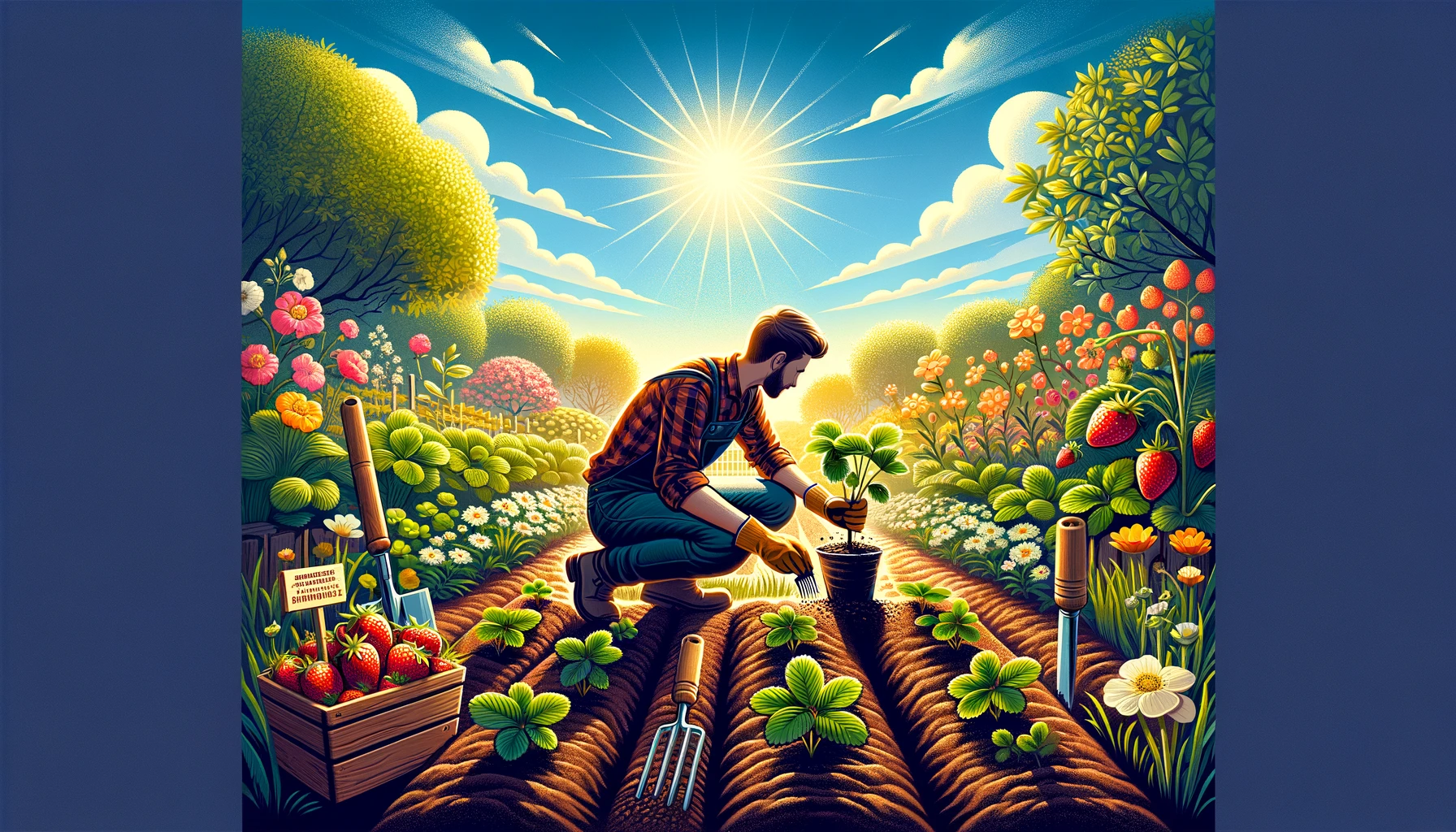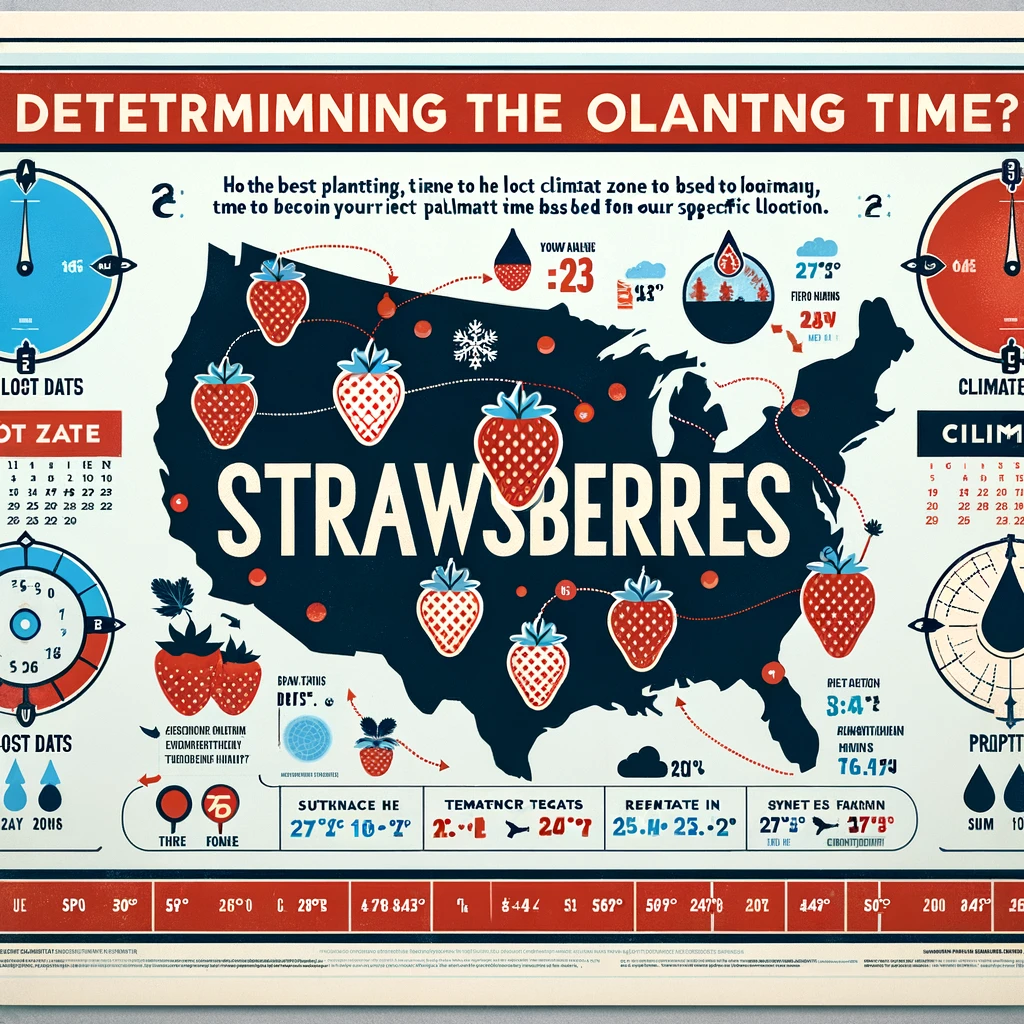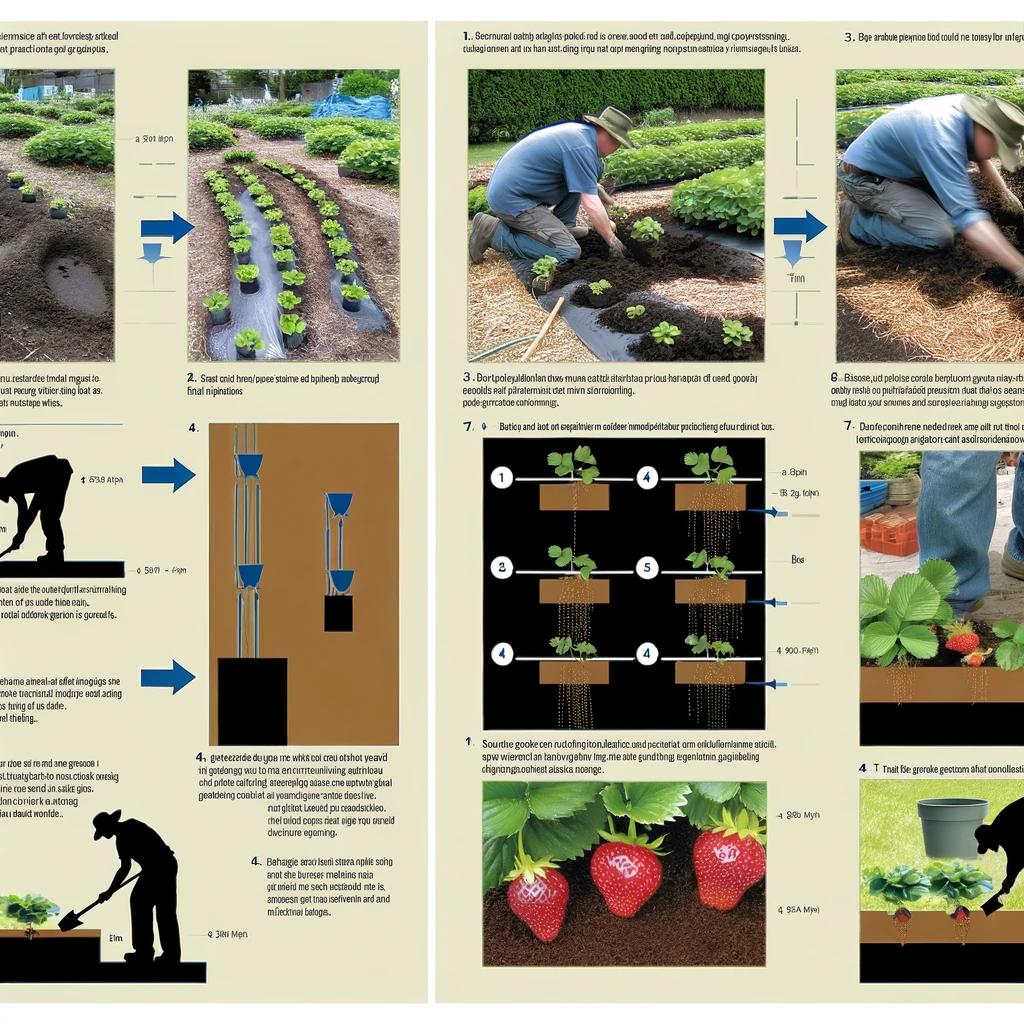When is the best time to plant strawberries in 2024?

Strawberries, with their sweet and juicy allure, are a favorite among gardeners and fruit enthusiasts alike. The joy of cultivating your strawberries is unparalleled, but success hinges on one crucial factor: timing. In this comprehensive guide, we will delve into the world of strawberry planting, when is the best time to plant strawberries, essential soil preparation, climate considerations, and care techniques for a bountiful harvest, and focus on the perfect timing for a bountiful harvest.
The Joy of Strawberry Cultivation
There’s something uniquely satisfying about plucking ripe, red strawberries from your garden. Their vibrant color, sweet aroma, and burst of flavor elevate the gardening experience to new heights. But to savor this satisfaction, you must grasp the art of perfect timing.
Planting Strawberries: A Timing Game
Strawberries are sensitive to when they are planted. Get it right, and you’ll be rewarded with a thriving strawberry patch. Get it wrong, and you might face disappointment. So, let’s explore the significance of planting strawberries at just the right time
Background
Before we dive into the specifics of planting strawberries, let’s explore some background information that will provide context to our journey.
A Brief History of Strawberry Cultivation
Strawberries have a rich history that dates back centuries. Native to North America, these small, sweet fruits were cultivated by indigenous peoples long before the arrival of European settlers. European colonists introduced cultivated strawberries to the continent, and the fruit quickly gained popularity.
Strawberry Varieties and Growing Requirements
Strawberries come in a variety of cultivars, each with its unique characteristics. Understanding these varieties and their growth requirements is crucial for successful cultivation.

Varieties of Strawberries
- June-bearing strawberries: These produce a single, large harvest in late spring to early summer.
- Everbearing strawberries: These yield two to three smaller harvests throughout the growing season.
- Day-neutral strawberries: These are known for their continuous fruiting throughout the season.
Growing Requirements
Strawberries thrive in well-drained, loamy soil with a pH level between 5.5 and 6.5. They require at least 6 hours of direct sunlight per day. Adequate spacing and proper care are also essential for healthy strawberry plants.
Favorable Climatic Conditions for Strawberries
Strawberries are sensitive to temperature and weather conditions. To maximize your harvest, it’s essential to understand the climate factors that influence strawberry growth.

Temperature
Strawberries are cold-hardy plants that can withstand chilly winters. However, they also require a certain number of chill hours (hours below 45°F or 7°C) to initiate flowering and fruit production.
Weather
Adverse weather conditions, such as heavy rains or late frosts, can damage strawberry flowers and fruits. Proper care and protection measures are necessary to safeguard your crop.
Best Time to Plant Strawberries
Now that we have a foundational understanding of strawberries, let’s delve into the heart of our guide: the best time to plant strawberries. Strawberry planting times vary depending on your climate zone, soil temperature, and local weather patterns.

Ideal Planting Seasons in Different Climate Zones
Strawberries can be grown in a wide range of climate zones, from temperate to subtropical. To determine the ideal planting season in your area, you’ll need to consider your USDA hardiness zone and the specific requirements of the strawberry variety you’re planting.
USDA Hardiness Zones
The USDA hardiness zone map is a valuable tool for gardeners. It divides North America into different zones based on average annual minimum temperatures. Understanding your zone can help you choose the right strawberry varieties and planting times.
For example, in USDA zones 4 to 6, where winters can be harsh, it’s best to plant strawberries in early spring, as soon as the soil is workable. In zones 7 to 9, where winters are milder, fall planting is also an option.
Impact of Soil Temperature and Weather on Planting
Soil temperature is a critical factor in determining when to plant strawberries. These plants thrive in cool soil conditions, but they also require warmth for germination and root development.

Tips for Determining Local Planting Time
While USDA hardiness zones provide a general guideline, local weather patterns and microclimates can vary significantly.

To pinpoint the ideal planting time for your strawberries, consider these factors:
Local Weather
Pay attention to local weather forecasts, especially the last expected frost date in your area. Planting too early can expose your strawberries to frost damage.
Soil Temperature
Use a soil thermometer to monitor soil temperature. Strawberries prefer soil temperatures between 50°F and 80°F (10°C to 27°C) for planting.
Regional Expertise
Consult with local gardening experts or agricultural extension services for insights into the best planting times specific to your region.
Preparing for Planting
Now that you know when to plant strawberries, it’s time to prepare your garden for these delightful additions. Proper soil preparation is crucial for ensuring your strawberry plants get off to a healthy start.

Guide on Soil Preparation
Strawberries thrive in well-drained soil rich in organic matter. Follow these steps to prepare your soil:

Soil Testing
Start by conducting a soil test to determine your soil’s pH and nutrient levels. Strawberries prefer slightly acidic soil with a pH of 5.5 to 6.5.
Soil Amendments
Based on the soil test results, amend your soil with compost, well-rotted manure, or other organic matter to improve its structure and nutrient content.
Raised Beds
Consider planting strawberries in raised beds, which offer excellent drainage and easier soil control. Raised beds also help protect strawberries from pests and diseases.
Importance of Soil pH and Nutrient Balance
Soil pH and nutrient balance are critical factors for strawberry growth. Let’s explore their importance in detail.

Soil pH
Strawberries thrive in slightly acidic soil with a pH level between 5.5 and 6.5. If your soil is too acidic or alkaline, it can hinder nutrient uptake and plant growth. Adjust the pH as needed to create the ideal growing conditions.
Nutrient Balance
Strawberries require essential nutrients like nitrogen, phosphorus, and potassium for healthy growth. Ensure your soil has the right balance of these nutrients to promote strong root development and fruit production.
Selecting the Best Location for Strawberry Plants
Choosing the right location for your strawberry plants can significantly impact their growth and productivity.

Sunlight
Strawberries need at least 6 hours of direct sunlight per day. Select a sunny spot in your garden that receives ample sunlight throughout the growing season.
Soil Drainage
Good drainage is essential for preventing waterlogged roots, which can lead to root rot. Avoid low-lying areas where water tends to accumulate.
Air Circulation
Proper air circulation helps reduce the risk of fungal diseases. Avoid planting strawberries in crowded or shady areas.
Planting Techniques
With your soil prepared and your planting time determined, it’s time to get your hands dirty and plant those strawberries.

Step-by-Step Planting Guide
Follow these steps for successful strawberry planting:

Choose Healthy Plants
Select disease-free strawberry plants from a reputable nursery or supplier. Look for varieties suited to your climate and growing conditions.
Prepare the Soil
Ensure your soil is well-prepared as discussed earlier, with the right pH and nutrient balance.
Planting Depth
Plant strawberries at the appropriate depth, with the crown (the point where the leaves meet the roots) at soil level. Planting too deep or too shallow can lead to poor growth.
Spacing
Space your strawberry plants 12 to 18 inches apart in rows, with 2 to 3 feet between rows. Proper spacing allows for good air circulation and prevents overcrowding.
Watering
Water your newly planted strawberries thoroughly to settle the soil and provide essential moisture for root development.
Mulch
Apply a layer of mulch, such as straw or pine needles, to conserve moisture, suppress weeds, and keep the strawberries clean.
Container Planting and Raised Bed Gardening Tips
Consider alternative strawberry-growing methods if you have limited garden space or poor soil quality.

Container Planting
Strawberries can thrive in containers, making them an excellent option for small spaces and patios. Choose a large container with good drainage, fill it with well-draining potting mix, and follow the same planting guidelines as for garden beds.
Raised Bed Gardening
Raised beds offer several advantages for growing strawberries. They provide better drainage, control over soil quality, and protection from ground-dwelling pests. Follow the same planting instructions as for garden beds, but be sure to build your raised bed with the appropriate dimensions and materials.
Care and Maintenance
Once your strawberries are planted, they require regular care to ensure healthy growth and a bountiful harvest.

Care Requirements for Strawberry Plants
You’ll need to attend to their basic care requirements to keep your strawberry plants thriving.

Watering
Strawberries need consistent moisture, especially during the growing season and fruit development. Water deeply and regularly, but avoid waterlogged soil.
Fertilizing
Fertilize your strawberries according to your soil test recommendations. Typically, you’ll apply a balanced fertilizer in the spring and again after the first harvest.
Pruning Techniques
Regularly prune your strawberry plants to remove runners and maintain good airflow. Pruning helps redirect energy towards fruit production.
Pest Control and Disease Prevention Strategies
Strawberry plants are vulnerable to various pests and diseases. Implement these strategies to protect your crop:

Pest Control
- Birds: Use bird netting or scare tactics to deter birds from feasting on your ripe strawberries.
- Slugs and Snails: Set up beer traps, apply diatomaceous earth, or use organic slug baits to keep these pests at bay.
- Aphids and Spider Mites: Use natural predators like ladybugs or insecticidal soap to control these pests.
Disease Prevention
- Gray Mold (Botrytis): Ensure good air circulation, avoid overhead watering, and remove infected plant parts promptly.
- Powdery Mildew: Apply sulfur-based fungicides as a preventive measure, and space plants properly for airflow.
- Verticillium Wilt: Plant disease-resistant varieties, rotate crops, and avoid planting strawberries in areas with a history of wilt.
Harvesting and Storage
The moment you’ve been patiently waiting for has arrived—harvesting your juicy strawberries. However, there are still some essential steps to ensure you enjoy the fruits of your labor to the fullest.

Identifying Ripe Strawberries
The key to truly delicious strawberries is picking them at the right time. Look for the following signs to identify ripe strawberries:
- Bright red color: Ripe strawberries are uniformly red with no green or white patches.
- Fragrance: Ripe strawberries emit a sweet, fruity aroma.
- Easy separation: Gently tug on a strawberry, and it should easily detach from the stem.
Harvesting Techniques
When it’s time to harvest your strawberries, follow these tips to ensure a gentle and successful harvest:
- Use sharp scissors or pruning shears to cut the stem just above the fruit, leaving a small portion of the stem attached.
- Avoid pulling or twisting the berries, as this can damage both the fruit and the plant.
- Harvest strawberries in the morning when temperatures are cooler, as they are firmer and less prone to bruising.
Storage and Preservation Methods
Once harvested, you’ll want to enjoy your strawberries as fresh as possible. Here’s how to store and preserve them:
- Store freshly picked strawberries in the refrigerator in a breathable container, such as a perforated plastic bag or a paper towel-lined container.
- Consume ripe strawberries within a few days to enjoy their peak flavor and texture.
- To extend their shelf life, consider freezing strawberries for use in smoothies, jams, or desserts.
related Products Section
Now that you’re well-versed in the art of strawberry planting and care, let’s introduce you to some essential gardening tools and resources that will aid you in your journey.

Quality Garden Trowel
A sturdy garden trowel is indispensable for planting strawberries and maintaining your garden. Look for one with a comfortable grip and a durable stainless steel blade.
Mulch for Weed Control
Mulching is crucial for weed control in your strawberry patch. Consider organic mulch options like straw or pine needles to keep your garden weed-free.
Fertilizers and Soil Amendments
Choose high-quality fertilizers and soil amendments tailored to strawberry needs. These products can enhance soil fertility and promote robust plant growth.
Resources
Strawberry Planting Calendar
Stay on top of your planting schedule with a strawberry planting calendar specific to your region. It will help you plan your planting and harvesting times for maximum success.
Online Gardening Communities
Join online gardening communities and forums to connect with experienced growers, seek advice, and share your strawberry-growing experiences.
Comprehensive Gardening Guides
Invest in comprehensive gardening guides that cover a wide range of topics, from soil preparation to pest control. These resources can be invaluable for both beginners and seasoned gardeners.
Conclusion
In the world of gardening, timing is everything, not only for planting but also for harvesting. While we’ve focused on the perfect timing for planting strawberries to ensure a bountiful harvest, it’s equally important to know the right time for harvesting other garden produce. For those of you cultivating a diverse garden, understanding the best time to harvest potatoes is crucial for maximizing yield and quality. Check out our guide on The Best Time to Harvest Potatoes to complement your gardening schedule, ensuring you enjoy the fruits of your labor across all your crops.
Remember that the joy of growing strawberries—and indeed, all garden produce—goes beyond the fruit itself; it’s a rewarding journey filled with anticipation, care, and the sweet taste of success. We encourage you to apply the tips and techniques outlined in this guide to create your own strawberry haven, and don’t forget to expand your gardening knowledge by learning about the best practices for harvesting other vegetables. Share your experiences, questions, and strawberry-growing adventures in the comments below. Happy strawberry planting!
FAQS
When is the best time to plant strawberries?
The best time to plant strawberries varies depending on your region and climate. In general, consider planting in early spring or late summer for cooler climates with distinct seasons. In milder climates, fall planting is an option. For more precise timing, consult local gardening resources or your agricultural extension office.
What are the different types of strawberry varieties?
There are three main types of strawberry varieties: June-bearing, everbearing, and day-neutral. June-bearing strawberries produce one large harvest in late spring or early summer. Everbearing strawberries offer two smaller harvests, and day-neutral strawberries provide a continuous supply throughout the growing season.
How do I prepare the soil for planting strawberries?
Prepare the soil for strawberries by testing its pH and amending it to a range of 5.5 to 6.8, which is ideal for strawberries. Ensure good drainage and rich organic matter in the soil. Remove weeds and debris from the planting area.
Can I grow strawberries in containers?
Yes, you can grow strawberries in containers. Container gardening is an excellent option for limited space or poor soil quality. Use large containers with drainage holes and a high-quality potting mix. Ensure the containers receive adequate sunlight and consistent moisture.
What are some common pests and diseases that affect strawberries?
Common pests and diseases that may affect strawberries include aphids, slugs, gray mold (Botrytis), and strawberry root rot. Regular monitoring, natural remedies, and good garden hygiene can help prevent and manage these issues.
How do I know when strawberries are ready to harvest?
Ripe strawberries are deep red in color, have a slightly yielding texture, and emit a sweet fragrance. Use scissors or pruning shears to cut the stem about 1/4 inch above the berry to harvest without damaging the plant.
What can I make with freshly harvested strawberries?
Freshly harvested strawberries are incredibly versatile. You can enjoy them as a healthy snack, add them to cereals or yogurt, create desserts like strawberry shortcake or pie, or make homemade jams and preserves.
Where can I purchase the recommended gardening tools and supplies mentioned in this guide?
We’ve included affiliate links to these products in the “Adding Affiliate Products” section of this guide for your convenience. You can purchase them through the provided links, which will support our website and gardening guides.
How can I get more involved in the gardening community and share my experiences?
Engaging with the gardening community is a great way to share experiences and learn from others. You can join online gardening forums, participate in local gardening clubs or workshops, and follow gardening influencers on social media platforms to connect with fellow enthusiasts.
What if I have specific questions or need personalized advice about planting strawberries?
If you have specific questions or need personalized advice related to strawberry planting or gardening in general, don’t hesitate to ask in the comments section of this guide. Our gardening experts are here to help you with tailored guidance.
